

Chinese Bow Holsters and Quivers of the Qing Dynasty
© Stephen Selby, 2000
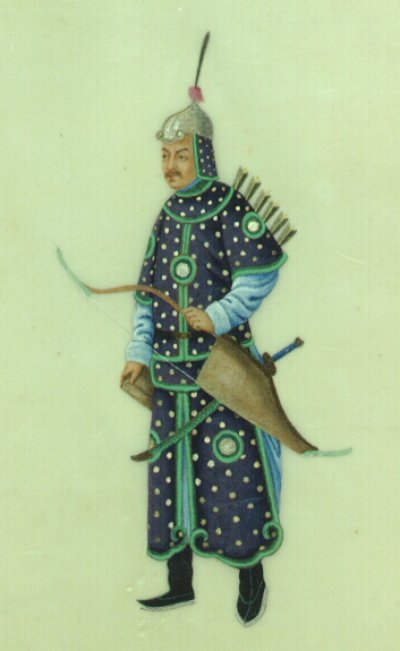
A Member has recently asked if I could provide some information on the design of Chinese quivers and related archery equipment. Answering this question could result in a long research paper. It would also tread on a number of academic toes, because you can argue about which Chinese quivers are 'Chinese', and which are Turkish or derived from other nationalities.
At the moment, other Members more qualified than me are preparing papers on Chinese quivers. To fill in, meantime, I thought I would provide some illustrations of three sets of late Qing Dynasty quivers and bow-holsters in my own collection. My illustrations are all photographed directly on a squared mat and the units are inches and tenths of inches. I shall therefore not provide further details of measurements.
Left: Qing guache painting of an officer of the Imperial Guard.
The first example is a quiver and holster dating from about the middle of the 19th Century and probably originating from the Mongolian banner of the Qing court.

Mongolian quiver from Peking. Mid-19th Century
This quiver is made of tanned ox leather which has been painted and lacquered on the outward-facing side. The inner side is undecorated and uses a heavier leather. The structure has a light wooden frame on three sides (excluding the mouth on the left in the photograph.) It is approximately one inch thick. There are two apertures in the face (below the crossed straps) to take a pair of differentiated arrows. The decoration consists of a gilded dragon in a circular boss (see below), and gilded borders with chrysanthemums. The outer borders were probably originally in gold, blue, pink and green, but the colours have now faded. The extremities of the quiver are decorated with heavy iron bosses inlaid with silver 'thunder' pattern designs. Below is a detail of the painted decorative roundel -
Detail of the Mongolian quiver. Dragon with (Buddhist) Pearl on rising from
waves.
This general quiver design is a very old Turkic design and it can be seen on some of the illustrations of Rashid-al-Din's account of the Mongolian invasion.
Here is the bow-holster which makes up this set -

Mongolian bow-holster from Peking. Mid-19th Century
The holster (above) is decorated similarly to the quiver. In addition to the dragon on the roundel, there is a lozenge with a picture of a phoenix (or goose). It has a strengthening piece of wood running along the string (bottom) side, giving it a depth of one inch on that side. On the bow-limb side (top) is riveted a leather tuck which would have allowed that edge to expand to the with of the bow-limb. There are loops to take a leather thong on the back at the two upper (left) extremities, as well as near the bottom (right) aperture.
The next pair is Chinese military issue, also from the mid-nineteenth Century.
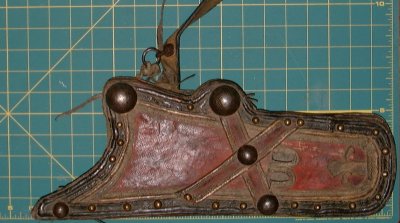
Chinese military issue quiver. Peking, mid-19th C.
This quiver is robustly constructed in red and black ox leather. It bears light and heavy iron bosses with concentric patterns in silver inlay at the extremities. Its construction is similar to that of the Mongol quiver, with a wooden frame 3/4" thick except at the mouth (right.)
Unlike the Mongolian quiver, it has thick felt padding on the inside to keep the arrows tight. The bottom-right boss has an iron ring at the back by which the quiver is attached to a leather belt. Two apertures for differentiated arrows are visible below the cross straps.
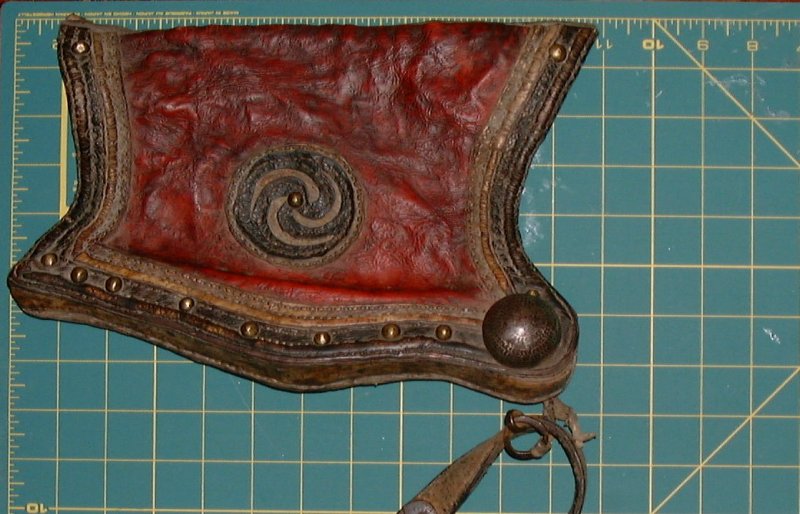
Chinese bow holster. Peking, mid-19th C.
As you can see, the matching holster is very small. In fact, its purpose is no more than to support the tip of the bow to assist the archer when mounting and dismounting from horseback. From its size and its point of attachment, it is clear that this holster could not support the bow independently: the bow was either held in the hand at the grip, or supported by the left arm as the archer mounted his horse.
The final quiver/hlster pair dates from the early part of the nineteenth century and is part of the ceremonial uniform of the Qing Imperial Guard at Peking (see the first illustration on this page). The complete set, together with a contemporary infantry bow and relatively small (modern) arrows, is illustrated.
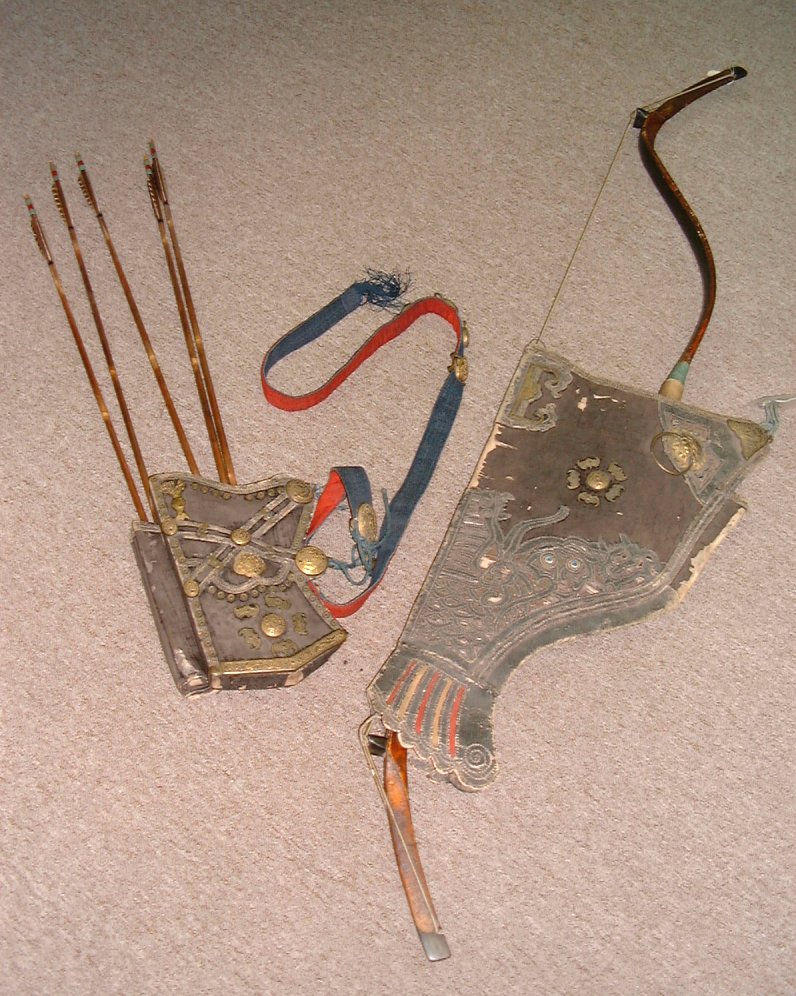
Qing Imperial guard quiver and bow holster with infantry bow and small (not
authentic) arrows.

Imperial Guard Quiver (Front View). Early 19th C. Peking.
The quiver is shallow and padded with felt covered with red silk. The outside of the quiver is covered with black silk (indicating the black banner division of the Imperial Guard). The studs bear the imperial dragon design. The central gilt plaque has hyacinths. The lower gilt boss is a floral design surrounded by five bats (a rebus for the word for 'fortune'.) At the left of the mouth (bottom left) is a gilt plaque with a vase containing three halberds (a rebus for "rise three ranks in the imperial examinations".) Other decorative studs are in the shape of chrysanthemum flowers.
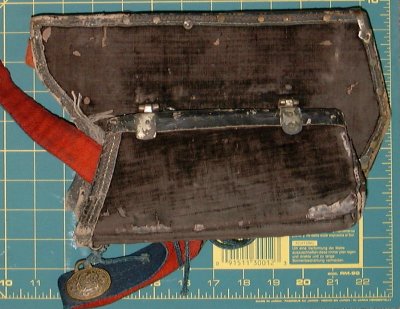
Imperial Guard Quiver (Rear View). Early 19th C. Peking.
Instead of apertures for differentiated arrows, this quiver has a separate, hinged quiver on the back. This hinged section has three separate pocket compartments for arrows.
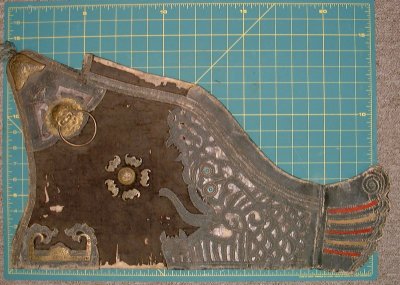
Imperial Guard Bow holster. Early 19th C. Peking.
The bow holster is designed to resemble a carp with a fanciful tail at the base. The eyes of the carp are in blue glass and the scales of the carp are richly embroidered with silver-wound thread (now oxidized to black.) The top of the mouth of the holster (top left corner) has a plaque in the shape of the head of the 'Kui' dragon. The squared-C design of the plaque at the string (lower) side of the mouth is not clear to me. A lion's head boss has a heavy ring through the nose to which the guard's scimitar scabbard was attached. A central boss with five bats is again used so symbolize "fortune". There is no wooden frame on this holster; but a fold in the bow-limb side will allow the holster to expand to about two inches to take the bow.
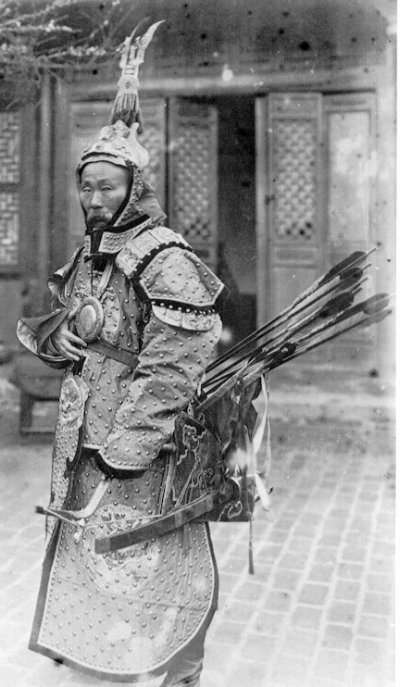
This photograph from the 1870s shows impressively how similar equipment was worn by a Chinese general. The bow-holster is only visible very obliquely, and the quiver cannot be seen at all, although the authentic arrows are clear. Note the combination of contrasting feather colours. In contemporary paintings I have seen, the contrasting colours were vermilion and white or black and white.
I have no detailed information about the arrangement of arrows in the military quivers, but a quick look through early Qing (Kangxi, Qianlong) palace paintings show a clear tendency to separate two arrows with red in the fletching and on the shaft adjacent to the fletching. (See "Emperor Qianlong Reviewing the Troops" painted by Castiglione in 1739. )
From their size, it is difficult to imagine these quivers holding the large whistling arrows of the size normally found on Qing arrows. However, it may still be that the two distinctive arrows were signalling arrows of some sort.
I look forward to your observations on this equipment. (I would also be keen to know of anyone interested in making a modern reproduction.
Last modified: 09 October 2000 . Copyright Stephen Selby, 2000.
Last up-dated October 09, 2000